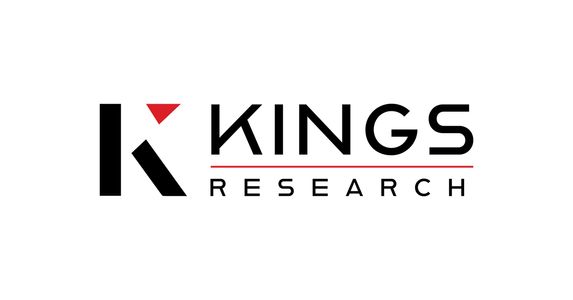Graph Database Market Boosted by Integration with Artificial Intelligence and ML
 Nikita Pawar
10 Sep, 2025
16 mins read
19
Nikita Pawar
10 Sep, 2025
16 mins read
19

The global graph database market was valued at USD 3,202.0 million in 2024 and is projected to reach USD 14,812.70 million by 2032, growing at a CAGR of 21.46% during the forecast period. This significant growth is driven by the increasing need for advanced analytics that can manage and interpret highly interconnected data, a task for which traditional databases are not well-suited.
Get Full Detailed PDF Report: https://www.kingsresearch.com/graph-database-market-2773
Understanding Graph Databases
A graph database is a type of NoSQL database that uses a graph structure for semantic queries with nodes, edges, and properties to represent and store data. It's designed to handle data relationships as a fundamental component, making it exceptionally efficient for analyzing complex connections.
- Nodes (or vertices) represent data entities, such as people, places, or products.
- Edges (or relationships) represent the connections between nodes. They are a first-class citizen in the graph model, meaning they're as important as the data itself. Edges are directional and can have properties.
- Properties are key-value pairs that can be stored on both nodes and edges, providing additional information.
Unlike relational databases, where connections are inferred through joins across multiple tables, a graph database stores these relationships explicitly. This design allows for extremely fast traversal of complex data networks, regardless of the data volume.
Key Growth Drivers
The remarkable growth of the graph database market is fueled by several key factors. One of the most significant is the explosive growth of interconnected data, particularly from social networks, the Internet of Things (IoT), and various digital platforms. Businesses are realizing the value in analyzing not just the data points themselves, but also the relationships between them.
A major driver is the escalating demand for real-time fraud detection in sectors like banking and e-commerce. Graph databases are uniquely suited for this task because they can quickly identify intricate patterns of fraudulent activity, such as a credit card being used by multiple individuals in different locations, or a network of accounts making suspicious transfers.
The rise of AI and machine learning also plays a critical role. Graph databases provide the ideal data structure for building and training machine learning models that need to understand relationships, such as recommendation engines. These engines, used by e-commerce and media platforms, leverage connections between users and products to provide personalized suggestions.
Finally, the increasing adoption of cloud computing makes graph databases more accessible. Cloud-based "database-as-a-service" (DBaaS) offerings from major providers have lowered the barrier to entry, allowing small and medium-sized businesses to leverage the power of graph technology without the complexities of on-premise infrastructure.
Common Applications
Graph databases are becoming indispensable across a wide range of industries for various applications:
- Social Networks: They are the foundational technology for platforms like Facebook and LinkedIn, enabling features like friend suggestions, targeted advertising, and community analysis by efficiently mapping user connections.
- Recommendation Systems: From Netflix suggesting movies to Amazon recommending products, graph databases analyze user behavior and their connections to similar users to provide highly accurate and personalized recommendations.
- Fraud Detection: As mentioned, they are used to uncover complex fraud rings and financial scams by analyzing transaction patterns and identifying hidden connections between accounts, devices, and individuals.
- Knowledge Graphs: These are used to model, integrate, and query complex information from diverse sources, helping search engines and smart assistants understand the relationships between concepts and provide more relevant answers.
- IT & Network Operations: In this space, graph databases are used to visualize network topology, troubleshoot issues by mapping dependencies between systems, and analyze security vulnerabilities.
Challenges and Future Outlook
Despite the robust growth, the market faces certain challenges. A significant hurdle is the high complexity and cost of implementation. While cloud-based solutions are helping, developing the right data model and writing efficient queries still requires specialized knowledge and can be a costly endeavor. The lack of standardization across different graph query languages also poses a challenge for developers.
Another technical challenge is scalability. While graph databases are optimized for traversing relationships, scaling them to handle truly massive datasets—with billions of nodes and edges—remains an active area of research and development.
Looking ahead, the future of the graph database market is incredibly promising. The integration of graph analytics and machine learning will continue to deepen, enabling new use cases in areas like drug discovery, supply chain optimization, and personalized medicine. As the technology matures and becomes more accessible, graph databases are poised to become a mainstream component of modern data infrastructure, further cementing their role in the data-driven world.
The global graph database market's growth is not uniform, showing significant regional variations driven by differing levels of technological maturity, investment, and industry-specific adoption rates. While North America currently holds the largest market share, the Asia-Pacific region is projected to be the fastest-growing market during the forecast period. This dynamic landscape reflects a global shift toward data-driven decision-making and the increasing recognition of graph databases' unique ability to handle complex, interconnected data
North America: The Dominant Market
North America, particularly the United States and Canada, leads the global graph database market. This dominance is attributed to a mature technological ecosystem, a high rate of digital transformation across industries, and the presence of numerous key players. The region's early adoption of advanced data technologies and substantial investments in research and development have positioned it at the forefront of the market.
Driving Factors:
- Robust IT Infrastructure: The U.S. has a highly developed IT infrastructure and a large concentration of technology companies, which are a primary source of demand for sophisticated data management solutions.
- Presence of Key Players: Many of the leading graph database vendors are headquartered in this region. This proximity fosters innovation and accelerates the commercialization of new technologies.
- Strong Industry Adoption: Industries like BFSI (Banking, Financial Services, and Insurance), IT & Telecom, and e-commerce are heavy users of graph databases for critical applications such as fraud detection, risk management, and personalized customer experiences. For example, financial institutions in North America are using graph databases to trace complex money laundering networks and identify subtle patterns of financial crime.
- Venture Capital Funding: The region's robust venture capital landscape provides ample funding for startups specializing in graph technology, further fueling market expansion.
Asia-Pacific: The Fastest-Growing Market
While currently holding a smaller market share than North America and Europe, the Asia-Pacific region is poised for an explosion in growth. The market here is expected to grow at the highest CAGR during the forecast period. This rapid expansion is driven by massive-scale digitalization efforts and government initiatives in key economies.
Driving Factors:
- Rapid Digitalization: Countries like China, India, and Japan are undergoing rapid digital transformation, with an enormous and expanding internet user base. This generates vast amounts of interconnected data from e-commerce, social media, and mobile services, creating a natural demand for graph databases.
- Government Initiatives: Governments across the region are investing in smart city projects and national data infrastructure. These initiatives, which involve managing complex data about public services, transportation, and citizens, are ideal use cases for graph technology. For instance, smart city programs in Singapore and Japan rely on graph models to analyze multi-layer relationships for urban planning and resource management.
- E-commerce and Social Media: Asia-Pacific is home to some of the world's largest and most active e-commerce and social media platforms. These companies are heavily leveraging graph databases to build sophisticated recommendation engines, understand consumer behavior, and combat online fraud.
- Rising Investments: Increasing foreign and domestic investment in technology and data analytics is accelerating the adoption of graph databases in industries like healthcare, logistics, and manufacturing.
Europe: A Steady and Evolving Market
Europe represents the second-largest market for graph databases. Its growth is stable and is driven by a strong focus on data privacy, technological innovation, and a growing recognition of the value of interconnected data analysis.
Driving Factors:
- Data Security and Compliance: The General Data Protection Regulation (GDPR) and other data privacy regulations have encouraged European businesses to adopt more transparent and secure data management practices. Graph databases, with their ability to map and visualize data relationships, are ideal for ensuring compliance and data governance.
- Industry 4.0 and Manufacturing: Countries like Germany, with their advanced manufacturing sector, are increasingly using graph databases for supply chain optimization, asset management, and predictive maintenance. Graph technology helps to model and analyze the complex relationships between machinery, components, and logistics in real-time.
- Open Data Initiatives: European governments are promoting open data portals and collaborative research projects. This push for data sharing and analysis across public and private sectors is creating new opportunities for graph database applications.
- Fintech Innovation: The region has a thriving fintech ecosystem, particularly in the UK and France, where graph databases are used to develop innovative solutions for fraud prevention, credit risk assessment, and personalized financial services.
In the rapidly evolving landscape of data management, the graph database market is defined not just by its overall growth but by the distinct contributions of its key players and the innovative technologies that are pushing the boundaries of what is possible. The competitive environment is a mix of established technology giants and specialized, agile companies, each vying for a position in this high-growth sector.
The Competitive Landscape: Established Giants and Innovative Specialists
The market is characterized by a dual structure. On one hand, you have the major cloud service providers who have integrated graph database capabilities into their broader platforms. These companies leverage their massive scale, existing customer base, and comprehensive ecosystems to offer managed graph solutions that are easy to deploy and integrate with other services. Their strength lies in providing a seamless, end-to-end data platform, appealing to large enterprises already invested in their cloud environments.
On the other hand, there are specialized vendors who focus exclusively on graph technology. These companies often pioneer new features and performance enhancements, driving the core innovation in the market. They are known for offering more powerful, native graph databases and advanced analytics tools, often with dedicated, high-performance query languages. Their expertise in graph theory and its practical applications gives them a competitive edge for complex, relationship-heavy use cases. This competition between generalists and specialists is a key factor in the market's continuous evolution.
The Role of Technology and Innovation
The future of the graph database market will be shaped by several technological trends. One of the most significant is the integration of graph technology with Generative AI (GenAI). Graph databases are proving to be a critical component for GenAI applications. By providing a structured, factual layer of interconnected data, they act as a "knowledge graph" that helps large language models (LLMs) to ground their responses in real-world facts, improving accuracy and reducing the phenomenon of "hallucinations." This synergy is opening up entirely new use cases and is a major area of investment for both established and emerging players.
Another key trend is the move toward serverless and managed services. The complexity of managing and scaling a graph database has been a significant barrier for many organizations. The rise of fully managed, cloud-based offerings is changing this, making the technology more accessible to a wider audience, including small and medium-sized businesses. These services handle the underlying infrastructure, allowing developers to focus on building applications rather than managing servers.
The development of new graph query languages is also an important area of innovation. While existing languages are powerful, the industry is moving towards greater standardization and ease of use. This will lower the learning curve for new developers and accelerate the adoption of graph technology across a broader range of applications. Furthermore, advancements in distributed graph computing are enabling databases to handle massive, multi-petabyte datasets, a crucial step for real-time analytics on a global scale.
In conclusion, the competitive landscape of the graph database market is a dynamic interplay of innovation and scale. As the demand for analyzing relationships within data continues to grow, key players are investing heavily in a new generation of technologies that will make graph databases faster, more scalable, and more accessible. The integration with AI and the move towards cloud-native, managed solutions are not just trends; they are foundational shifts that will define the market's trajectory, ensuring its continued rapid growth in the years to come.
Written By:
Nikita Pawar



Hotels at your convenience
Now choose your stay according to your preference. From finding a place for your dream destination or a mere weekend getaway to business accommodations or brief stay, we have got you covered. Explore hotels as per your mood.


